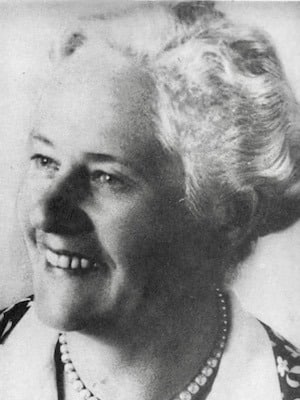Gertrud Hurler
Gertrud Hurler (1889 – 1965) was an Austrian-German pediatrician.
Gertrud Hurler trained as a paediatrician at Hauner Children’s hospital during which time she published the account of the condition which now bears her name.
In 1919 she relocated to Neuhausen to work as a paediatrician in private practice, where she worked for the next 45 years.
In addition to her clinical activities she was associated with the local orphanage, served on many medical committees and was a pioneer in the establishment of a maternal postnatal service.
Eponymously remembered for her description of Hurler Syndrome (1919).
Biography
- Born Gertrud Zach on September 1, 1889 in Taberwiese, Prussia
- 1913 – MD, University of Munich
- 1914 – Married Dr. Konrad Hurler, veterinary surgeon (one daughter and one son)
- 1915-1918 Pediatric training at Hauner Children’s Hospital
- 1919 – Wrote up case of what later known as Hurler Syndrome in German: Über einen Typ multipler Abartungen, vorwiegend am Skelettsystem, published in the Zournal Kinderheilk
- 1919-1964 – Pediatrician in Neuhausen
- Died 1965
Medical Eponyms
Hurler Syndrome (1919) [Mucopolysaccharidosis I (MPS I)]
Rare autosomal recessive inherited lysosomal disorder caused by the absence of alpha-L-iduronidase enzyme which is responsible for degradation of glycosaminoglycans (GAG or mucopolysaccharides). This results in the buildup of dermatan sulfate and heparin sulfate in multiple tissues, resulting in progressive deterioration and eventually death. Incidence is approximately 1 in 100,000 births.
Clinical features are varied. Most commonly characterised by dwarfism, hunchback, coarse (gargoyle-like) facies, mental retardation, skeletal dysplasia, clouding of the cornea, sensorineural deafness, hepato-splenomegaly, noisy respiration, cardiac abnormalities, and an enlarged tongue.
History of Hurler syndrome
1917 Charles A. Hunter (1873-1955) read a report at the Royal Society of Medicine, London, concerning two boys admitted to the Winnipeg General Hospital in 1915. The key features included dwarfism, coarse facies, hepatosplenomegaly, digital contractures, mental retardation and deafness. The boys had manifestations similar to those of Hurler’s patients but with less severe manifestations and no clouding of the cornea.
1919 Gertrud Hurler described a syndrome of corneal clouding, dwarfing skeletal dysplasia, spinal malalignment and mental retardation (published 1920). Her report was based upon two infants previously presented to the Munich Paediatric Society (1919) by her chief, Prof Meinhard von Pfaundler (1872-1947), also published in 1920. Hurler did not mention this report and with medical communication disrupted by the war it is likely that she was unaware of Hunter’s 1917 report.
1921 The disorder, previously called gargoylism, lipochondrodystrophy or osteochondrodystrophy, then became known as Hurler syndrome or less commonly Pfaundler-Hurler syndrome or Hunter-Hurler syndrome.
1954 The probability of X-linked recessive inheritance (for Hunter syndrome) was raised by Beebe and Formel who recorded a family with nine affected males.
1962 Harold Glendon Scheie (1909-1990) identified a syndrome characterised by progressive corneal clouding, coarsening of the facies and general dysplasia of the skeleton. This milder form of Hurler syndrome was subsequently termed Scheie syndrome.
1972 In the 1960’s the syndromic identity was confirmed on a clinical, genetic and biochemical basis, and the eponymous terms were separated. Victor Almon McKusick (1921-2008) followed up the family fifty years after Hunter’s original report. He published photographs of the children together with an account of their clinical course in his textbook of Heritable Disorders of Connective Tissue (1972 4e), and confirmed the children had Hunter syndrome (mucopolysaccharidosis type II).
Hurler Syndrome is one of the 11 disorders of the mucopolysaccharidoses (MPS). The term Hurler syndrome is now reserved for MPS I, with Hunter syndrome designated for MPS II. MPS has been further divided into three separate syndromes: Hurler syndrome (MPS I-H), Hurler-Scheie syndrome (MPS I-H/S), and Scheie syndrome (MPS I-S), listed from most to least severe.
Major Publications
- Hurler G. Über einen Typ multipler Abartungen, vorwiegend am Skelettsystem. Zeitschrift für Kinderheilkunde, 1920; 24(5-6): 220-234.
References
Biography
- Beighton P, Beighton G. HURLER, Gertrud. In: The Man Behind the Syndrome. Springer 1991: 82-84 [Portrait with permission Beighton P]
- Ogilvie M, Harvey J eds. The Biographical Dictionary of Women in Science: Pioneering Lives From Ancient Times to the mid-20th Century. 1: A-K. New York, NY: Routledge. 2000
Eponym
- Hunter C. A Rare Disease in Two Brothers. Proc R Soc Med. 1917; 10(Sect Study Dis Child): 104-116.
- Hurler G. Über einen Typ multipler Abartungen, vorwiegend am Skelettsystem. Zeitschrift für Kinderheilkunde, 1920; 24(5-6): 220-234.
- Pfaundler M. Demonstrationen über einen Typus kindlicher Dysostose. Jahrbuch für Kinderheilkunde und physische Erziehung 1920; 92: 420
- Beebe RT, Formel PF. Gargoylism: sex-linked transmission in nine males. Trans Am Clin Climatol Assoc. 1954;66:199-207.
- Scheie HG, Hambrick GW Jr, Barnes LA. A newly recognised forme fruste of Hurler’s disease (gargoylism). American Journal of Ophthalmology, 1962, 55: 753.
- McKusick VA. The mucopolysaccharidoses. In: Heritable disorders of connective tissue. 4e. 1972: 521-686
- Moore D, Connock MJ, Wraith E, Lavery C. The prevalence of and survival in Mucopolysaccharidosis I : Hurler, Hurler-Scheie and Scheie syndromes in the UK. Orphanet J Rare Dis. 2008;3:24
Graduated from Cardiff Medical School in 2017 with MBBCh and BSc in Psychology and Medicine. Currently working as a doctor in the emergency department at Sir Charles Gairdner Hospital in Perth, Australia.



